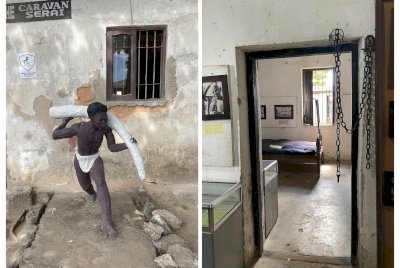Tanzania
The Central Slave and Ivory Trade Route
Site Info
Official Information
- Full Name
- The Central Slave and Ivory Trade Route (ID: 2095)
- Country
- Tanzania
- Status
-
On tentative list 2006
Site history
History of The Central Slave and Ivory Trade Route
- 2012: Incomplete - not examined
- .
- 2011: Incomplete - not examined
- .
- 2010: Incomplete - not examined
- .
- 2006: Added to Tentative List
- Added to tentative list
- Type
- Cultural
- Criteria
Links
- UNESCO
- whc.unesco.org
All Links
UNESCO.org
- whc.unesco.org — whc.unesco.org
Community Information
- Community Category
- Human activity: Transport and Trade
Travel Information
Recent Connections
-
Incomplete more than once
2010, 2011, 2012
Connections of The Central Slave and Ivory Trade Route
- World Heritage Process
-
-
Incomplete more than once
2010, 2011, 2012
-
News
No news.
Recent Visitors
- Mstrebl1990
- Roman Bruehwiler
- Patrik
- Ask Gudmundsen
- Shannon O'Donnell
- Alberto Rodriguez Gutierrez
- Hadrianus
Visitors of The Central Slave and Ivory Trade Route
Community Reviews
Show full reviewsRandi Thomsen
The Central Slave and Ivory Trade Route
The Central Slave and Ivory Trade Route (On tentative list)

Visit July 2022
Bagamoyo is one on several sub-sites in the tentative site of “The Central Slave and Ivory Trade Route”. It is now a small town, 1,5 hours north of Dar es Salam. We booked a trip by car with driver through our travel agent.
It is a historical town with ruins of early settlement from 1300 century (Kaole), but the town is more famous for its part in slave trades. This was the end of the Central Slave Route with slaves from the area around Lake Tanganyika, Kongo, Uganda. The journey by foot, chained and with little food and water, lasted up to 6-8 months. Many of them never made it all the way to Bagamoyo. Here they were examined and stored. The strongest were sent to slave market in Zanzibar, the rest to plantations along the shore. In late 1800 the trade was abolished by various countries, but trade was secretly going on until 1920’s when it was totally abolished in Tanganyika. The abolition of slavery took a long time and had many consequences both for the slaves with no skills and for the plantation owners without their cheap labourers. It is just recently that descendants of slaves were treated with equal rights. They had a long way to go to be accepted, and our guide told us there is still a shame to be offspring of slaves.
We visited the old Caravan Serai Museum. This used to be the house were the traders …
Keep reading 0 comments